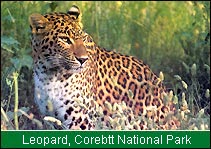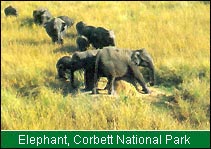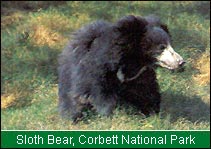 |
 |
 |
||
|
||||
Wild Expeditions India
-------------------------------------------------------------------------------------------------------------------------------------------------------------------------------------------------
Wild Expeditions India
Corbett National Park ¤ Historical Background ¤ Habitat ¤ Map of Corbett National Park
Mammals Checklist ¤ Reptiles Checklist ¤ Birds Checklist ¤ Wildlife Information
Wildlife Watching ¤ Conservation ¤ Tours with Corbett
-------------------------------------------------------------------------------------------------------------------------------------------------------------------------------------------------
Wild Expeditions India
Corbett National Park ¤ Historical Background ¤ Habitat ¤ Map of Corbett National Park
Mammals Checklist ¤ Reptiles Checklist ¤ Birds Checklist ¤ Wildlife Information
Wildlife Watching ¤ Conservation ¤ Tours with Corbett
-------------------------------------------------------------------------------------------------------------------------------------------------------------------------------------------------
Wildlife Information
Corbett is the ultimate tiger haven. But because of its thick undergrowth
and tall grass, it is actually quite difficult to spot tigers. A plentiful prey
base does, however, support a relatively large tiger population. According to
the official 2001 census, there are an estimated 137 tigers in the reserve.
Visitors often report seeing a tiger on the main tar road between the Dhangari
entrance gate and Dhikala. If you do not see one, pugmarks are a sure bet -
a sign that they are around. Also ask guides, drivers and mahouts to point out
favourite scratching posts where tigers leave tell-tale "I was here"
signatures.
undergrowth
and tall grass, it is actually quite difficult to spot tigers. A plentiful prey
base does, however, support a relatively large tiger population. According to
the official 2001 census, there are an estimated 137 tigers in the reserve.
Visitors often report seeing a tiger on the main tar road between the Dhangari
entrance gate and Dhikala. If you do not see one, pugmarks are a sure bet -
a sign that they are around. Also ask guides, drivers and mahouts to point out
favourite scratching posts where tigers leave tell-tale "I was here"
signatures.Apart from tigers, you could see as many as 50 different species of mammals. Leopards are often seen in the hilly areas and outskirts of the park, while the larger and more powerful tigers dominate the prime areas. Jungle cats and the rare fishing cats frequent the grasslands and the riverine areas.
Elephants are the dominant non-feline mammals of Corbett. They can be seen bathing, drinking and feeding in the Ramganga river and its food-rich surrounds. Herds are seen as frequently as lone tuskers. You could chance upon them in thick vegetation or watch them from a distance from machans built over salt licks and water holes throughout the park. Once elephants used to migrate out of the park, but the Ramganga reservoir has cut off a migratory route and some herds are now mostly confined to the park.
Relatively easily visible are chital, sambar (the largest deer in Asia)
 and barking deer. Wild boar may suddenly cross the jungle road as you go by.
Huge males wander in sounders with females accompanied by striped and marked
piglets. If startled by your presence, the group often takes a moment or two
to re-group from their foraging, and make their getaway through the undergrowth
almost in single file. Large male boars can be dangerous if cornered and have
been known to fatally wound tigers in battle. Rare Himalayan animals - the ghural
(goat antelope) and serow can also be seen in Corbett.
and barking deer. Wild boar may suddenly cross the jungle road as you go by.
Huge males wander in sounders with females accompanied by striped and marked
piglets. If startled by your presence, the group often takes a moment or two
to re-group from their foraging, and make their getaway through the undergrowth
almost in single file. Large male boars can be dangerous if cornered and have
been known to fatally wound tigers in battle. Rare Himalayan animals - the ghural
(goat antelope) and serow can also be seen in Corbett.In the Bijrani area, chances of seeing sloth bear are excellent. Attracted here by both termites and the sweet nectar of mahua flowers, the bears have often been observed in an inebriated state when the mahua liquor ferments in their stomachs. Himalayan black bears may sometimes be seen during bitter winters at Kanda, but they rarely descend to the lower slopes or valleys.
Jackals come close to the Ohikala campus, where they seem to thrive on small rodents and mammals such as the blacknaped hare that live in the chaurs. The call of the langur is one of Corbett's most distinctive sounds. Spread throughout the park, these monkeys can often be seen teamed up with barking deer and chital that have learned to feed on the fruit and leaves dropped by monkeys. The existence of the dhole or wild dog in Corbett is a controversial subject, and reported sightings seem to be restricted to the Bijrani area. They are pack animals with a very specialised community hunting technique. When food sources are thin, males may take to hunting alone, or at best with a breeding female and their cubs.
The gharial (a fisheating crocodile that sports a distinctive pot-like growth on its snout) and the mugger or marsh crocodile are both found in the Ramganga river, which is also rich in mahseer, goonch and trout. The gharial were bred in captivity and released into the park after having been brought back from the brink of extinction. Tortoises and fresh water turtles are effective scavengers and can also be seen. Corbett is a very important breeding ground for Indian reptiles. The Indian python, viper. king cobra and krait - all venomous - inhabit the park. Monitors and other lizards are amongst the 25 reptile species that have been documented here.
AVIFAUNA:The Corbett Tiger Reserve is one of the world's best
 birding habitats. Several birdwatching camps are held by the Forest Department
to train young school-going children in the science of ornithology. One reason
for the rich birdlife is said to be the park's location in the transition zone
between high altitudes and the plains. Additionally, migratory birds are attracted
to the river, especially species that migrated vertically up (in summer) and
down the Himalaya (in winter). Winter migrants include the Greylag and the Barheaded
Goose, Great Crested Grebe, snipe. sandpiper, gull and the wagtail.
birding habitats. Several birdwatching camps are held by the Forest Department
to train young school-going children in the science of ornithology. One reason
for the rich birdlife is said to be the park's location in the transition zone
between high altitudes and the plains. Additionally, migratory birds are attracted
to the river, especially species that migrated vertically up (in summer) and
down the Himalaya (in winter). Winter migrants include the Greylag and the Barheaded
Goose, Great Crested Grebe, snipe. sandpiper, gull and the wagtail. Habitat changes have actually benefited a large number of water birds such as cormorants, darters. herons, egrets. storks. Fishing Eagles and kingfishers whose populations have increased manifold. Moorhens have become permanently resident in the park.
The lammergeier. King and Griffon Vulture are found here. Himalayan Golden Eagle, Steppe Eagle. Honey-Buzzard. Crested Serpent Eagle. long-legged Buzzard and kestrel can also be seen. Apart from the peacock. you may see the Kalij and Red Jungle Fowl.
The Brown Fish Owl is another species you may spot. There are as many as 17 kinds of woodpeckers, five different species of barbets (including the Great Himalayan Barbet). five different types of wagtails. minivets. redstarts, finches. cuckoos. babblers, parakeets and thrushes and more than 50 kinds of raptors (birds of prey).
Nights are resplendent with nocturnal birds like night jars and owls. Stone Plovers and Stone Curlews are active hunters on the night waters of the river. There can be no doubt about it. This is an avian wonderland!

Corbett's Big Ten
Elephant
Tiger
Leopard
Sloth Bear
Ghural ( goat-antelope)
Gharial
Sambar
King Vulture
Pallas's Fishing Eagle
Python
| Home | About Us | FAQ's | Contact Us | Commendations | Reservation |
| Copyright © Wildlife India Plus ( All Rights Reserved. ) | Web Development & SEO Services by |

